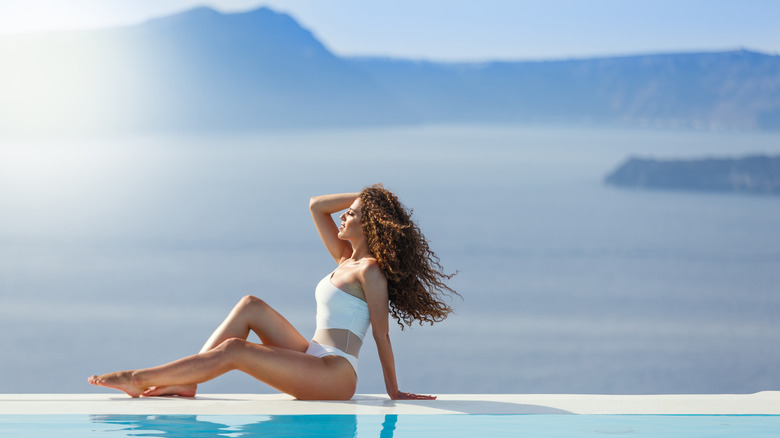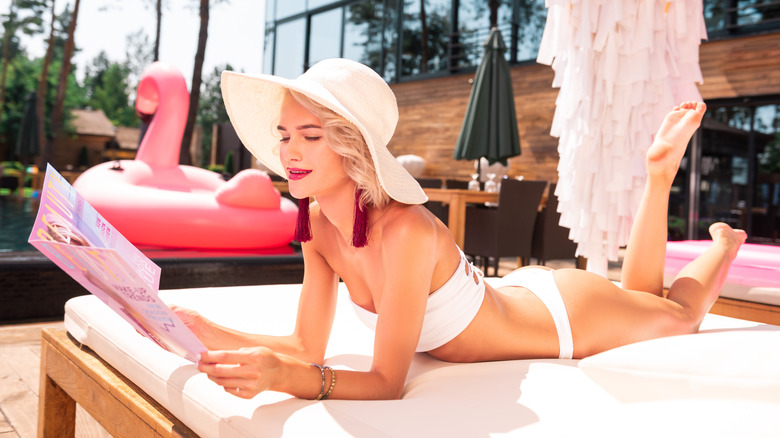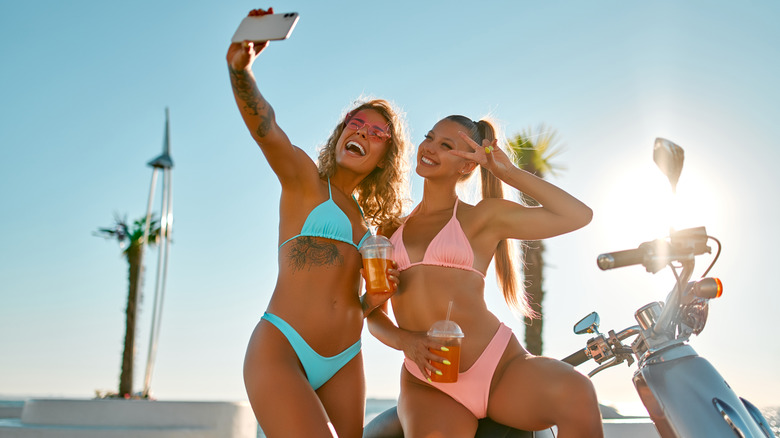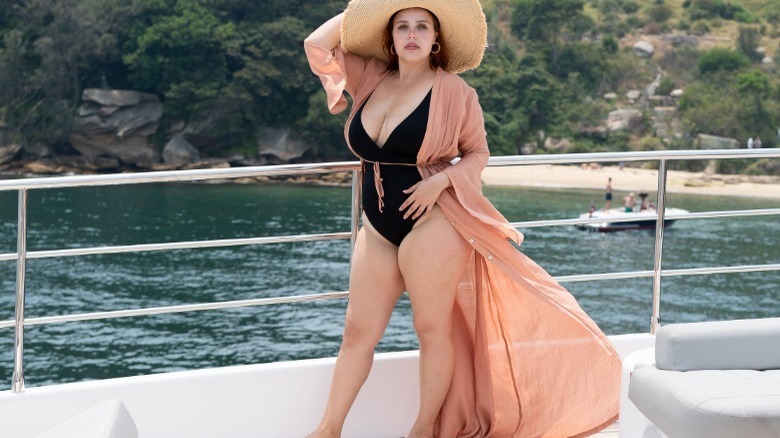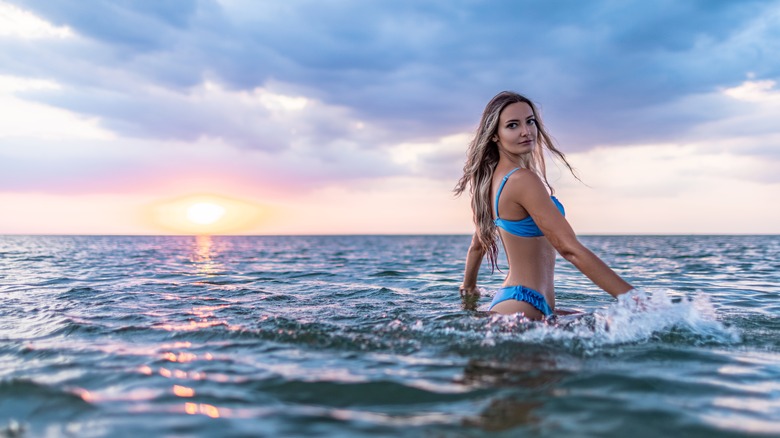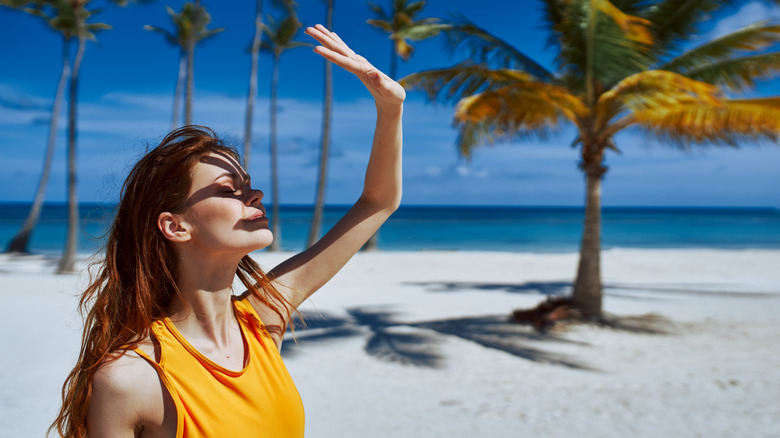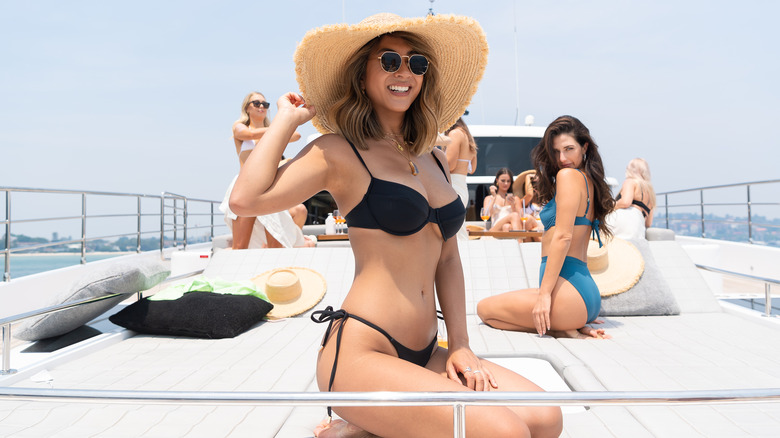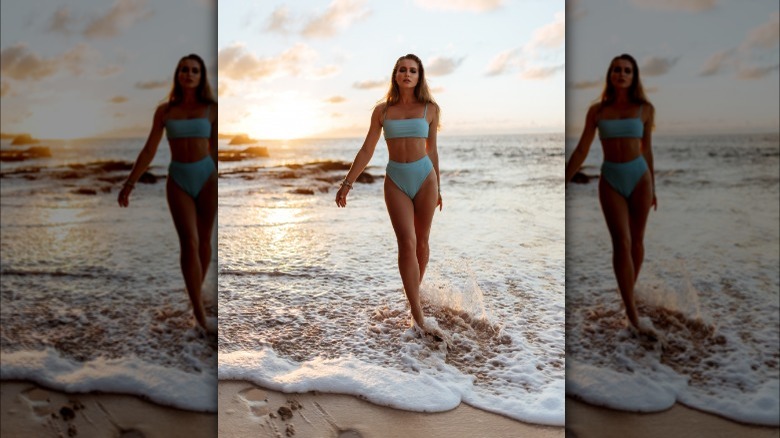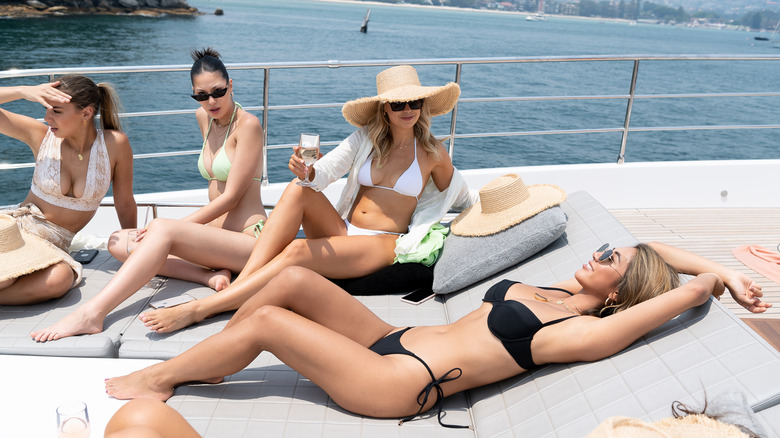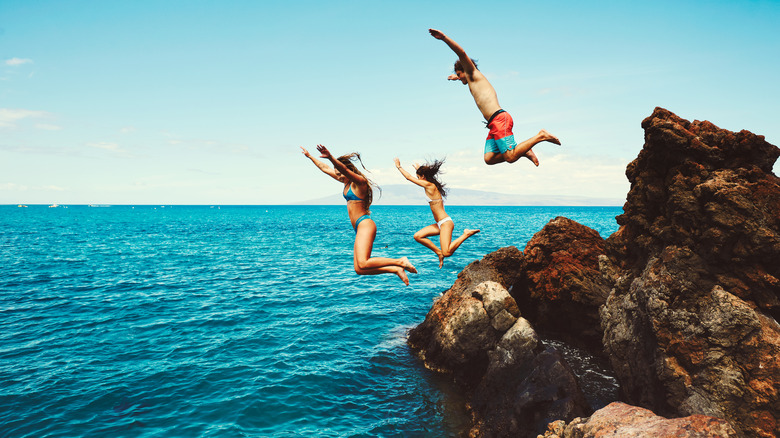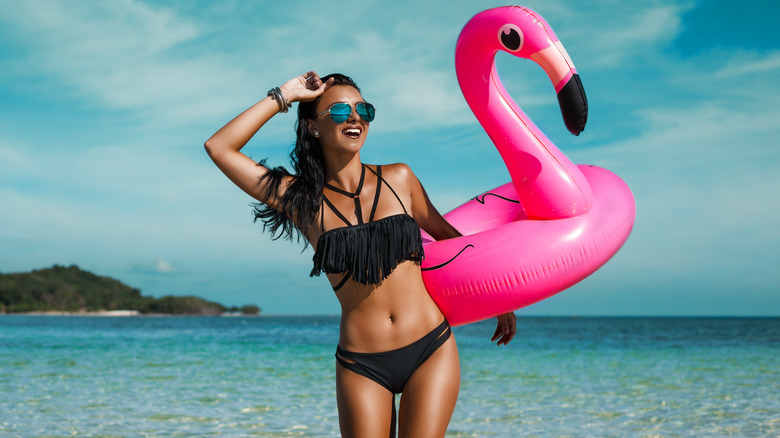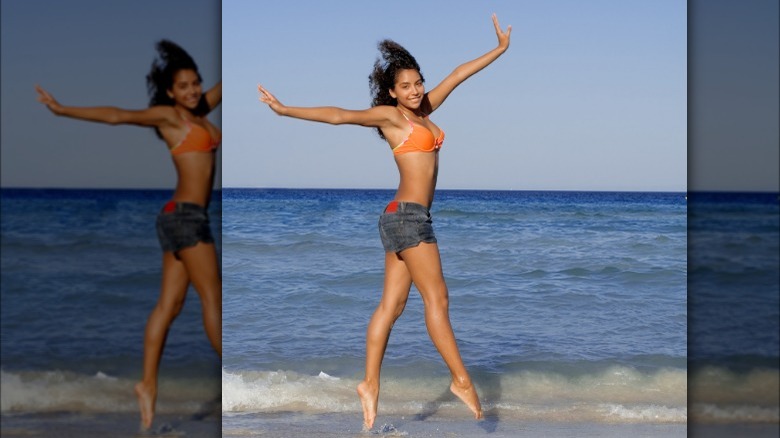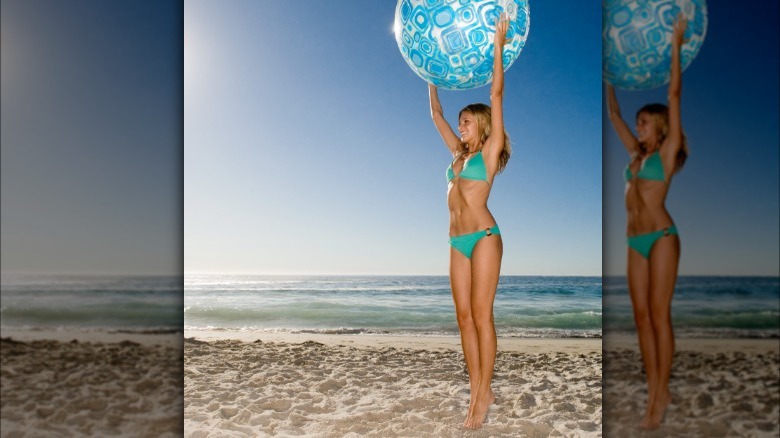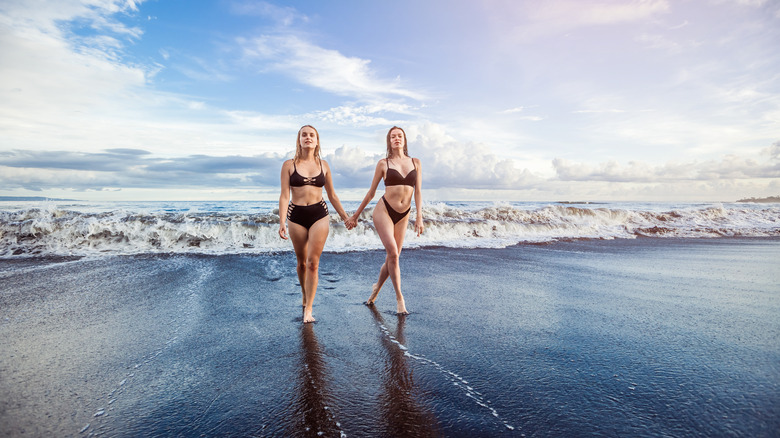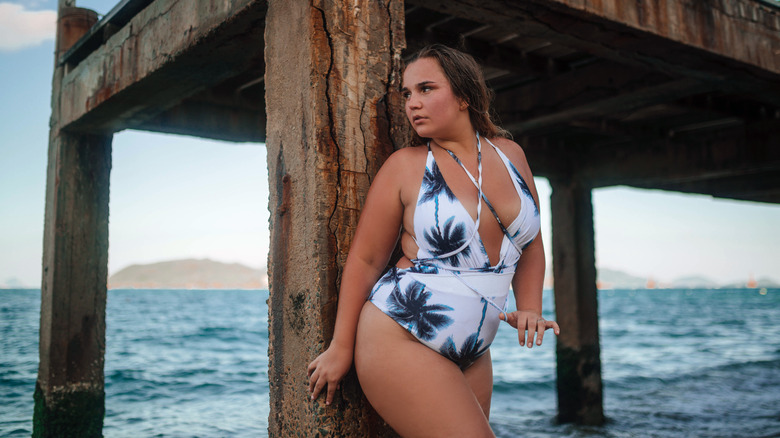Master The Art Of The Bathing Suit Beach Pic With Our Tips
If you want to look fantastic in all your bathing suit beach pics, the most crucial first step is to find the perfect bathing suit for your body type. You'll also want to style a swimsuit coverup that looks amazing on you and complements your bathing suit. Depending on your skin tone, it could be beneficial to apply sunless tanner to achieve the perfect bronze before you hit the beach. You'll also want to arrange your hair in an attractive hairstyle and possibly apply waterproof makeup if that suits your personal style.
Although it's important to attend to your grooming and your overall look, these are not the only details to consider when you plan a beach photo shoot. External factors, such as the lighting and landscape, play as much of a role in the outcome of your beach pics. So, after you've chosen your swimsuit and perfected your grooming, the following tips will help you maximize the chances you'll end up with stunning beach photos to post on social media and share with all your friends.
Study model poses before your beach photo shoot
Many women feel uncomfortable wearing a bikini at all, let alone posing for pictures wearing a bikini or any bathing suit. This discomfort is a hurdle to overcome if you want to take spectacular bathing suit beach pics.
Unless you have previous modeling experience, chances are good you haven't already spent much time posing in a bathing suit. You can bump up your confidence levels and feel more comfortable posing in one if you choose and practice your poses ahead of time. A possible shortcut: You can emulate tried-and-true model poses you find in magazines, swimsuit catalogs, or online photos.
Mark Morgan, an Australian photographer who collaborates with major surf and swimwear brands, advises models to "look at images you like, and practice the poses. Look at hands, eyes, lips, neck, hips... try your best to replicate the look in front of a mirror." Even if you're not a professional model, this advice can help you improve the way your photos turn out. Morgan says, "When it comes to your next photo shoot, you'll feel a lot more confident."
Pose looking up toward the camera
If you're taking selfies, you can achieve interesting photos by varying the height at which you hold your phone or camera. Expect a more flattering outcome if you hold the device above your head and look up at it rather than holding it below your head and looking down at it. Model Chrissy Teigen tells Fashionista, "I will not allow anyone to take a picture of me without that camera basically up in the sky and shooting down on me. Never allow someone to take a photo shooting upwards toward your face."
Photography educator and former photojournalist Joe Edelman explains that photographers snapping their subjects' portraits from an elevated angle can help disguise the look of a double chin. Edelman says, "Shooting from a higher camera angle will help to thin [the] body. This is because you essentially create an optical illusion by putting their head closer to the camera and their body further away." Edelman adds that this applies to anyone regardless of size.
If you work with a photographer who's shorter than you, you can sit or lie down to get below them when they take your pictures; another alternative is to ask them to stand on a sand dune or bench and tilt the camera down at you when they shoot your portrait.
You don't have to smile
Instead of forcing a smile or faking a grin when you pose for beach photos, share a display of genuine emotion with the camera. Photographer Adam Gil tells Leux Magazine, "If I'm shooting portraits, I want to capture the full expression my model is displaying. They don't have to be smiling, whatever emotion is driving them at the moment is important." Gil reveals a photographer's trade secret for ensuring your pictures turn out as striking as possible. He says, "I want the very moments their emotions on the inside align with their bodies on the outside. Those are usually the most stunning photographs."
Contemplate how you're actually feeling at that moment. You could conjure a dreamy expression or a serious one. You could make a comical face. You could shoot a playful wink in the photographer's direction. If you're genuinely feeling happy at that moment, go even further than smiling — let the photographer capture you giggling or laughing. Laughter prompts your eyes to light up and radiate an appearance of joy. This can result in fun, memorable photos you're sure to enjoy viewing and sharing.
Know the best times of day for taking beach pics
Successful photography relies on effective lighting. In an outdoor environment, the sun is the default source of light. Since the sun is in continuous motion all day long, the quality of the light at any given time of day varies based on its position and intensity. There are dramatic differences in the way the light looks between sunrise and noon because the sun casts shadows in different directions based on its position in the sky. To execute the most flattering outdoor photos, you'll need to either take advantage of the times when the sun is positioned optimally or compensate for the deficiencies when it isn't.
Darren Rowse, professional blogger and founder of Digital Photography School, clarifies the ideal time frame for scheduling your beach photo shoot, saying, "The golden hours – that is, the hour or two just after sunrise and the hour or two just before sunset – are some of the absolute best times for beach photography."
Understand the challenges mid-day beach photos present
Before your beach photo shoot, it's important to be aware of the challenges you may encounter during mid-day. As Ankush Tripathi at Pixpa.com explains, "If you're headed to the beach for portraits, don't do it in the middle of the day. The sun is too harsh when straight overhead and the light bouncing off the sand adds to your problems. Shooting in these conditions results in nasty facial shadows and blown highlights."
It makes sense to follow this advice in cases where you're headed to the beach solely to take pictures. Otherwise, this tip isn't always realistic. If you're taking a beach vacation, you'll want to enjoy — and photograph — every moment of it. When your vacation time is limited, you aren't going to want to stop taking pictures in the middle of the day just because the light at the time isn't optimal.
In cases like these, Tripathi suggests photographing black-and-white portraits. This way, you can capture dramatic contrasts when the sun is directly overhead, and those contrasts result in interesting black-and-white photos. According to Tripathi, it's also possible to defeat harsh mid-day shadows by using a reflector; this is a viable option if you're inclined to invest in photography gear for enhancing your photo session.
Shade your face
Shading your face is another way to overcome the challenges introduced by direct overhead sunlight. Eleanor Godley at Honey Boudoir Photography poses the question, "Why do we look at a photo or in the mirror and not like what we see?" Godley's answer: "It's usually how the light is falling on your face." You can improve your outdoor photos if you take steps to avoid irregular lighting on your face when the sun is high in the sky. Godley advises, "Go under an awning or a tree and face away from the sun. Hopefully, you will have lots of open space in front of you to avoid a dark face."
The beach isn't always reliably going to offer you a landscape filled with trees, awnings, or similar shady spots in which to take cover. If you know ahead of time that you'll be taking photos in a treeless environment, be proactive about bringing your own shade to the beach with you. You can take a visor or sun hat to wear, or you could pack a beach umbrella for lounging underneath.
Take advantage of backlighting when you pose
In the book "Portrait Photography: From Snapshots to Great Shots," portrait photographer and author Erik Valind shares insights on how to ensure your face will glow and appear evenly lit in your outdoor photographs. The trick is to locate the sun and pose with your face directed away from it. Photographers refer to this technique as backlighting.
Valind warns fellow shutterbugs that shooting their subjects in this position will require a camera exposure adjustment; without this compensation, the suggested positioning obscures subjects' faces, creating darkened silhouettes instead of brightly lit, recognizable facial features. Valind explains via the Peachpit.com, "When you readjust your exposure for this type of shot, the result will be even lighting on the face and nice, bright backlighting, which works nicely as both hair light and rim lighting." If you decide to try experimenting with creating silhouetted images, your photographer can use backlighting without needing to lengthen the exposure time.
Strike a comfortable pose
Photographers frequently deal with tense portrait photography subjects, and it isn't uncommon for the subjects' tension to ruin the look of the pictures.
When you're standing up to pose for a portrait photo, think of something to do with your hands other than crossing them in front of you. We make this suggestion based on advice from former photojournalist and portrait photographer Hillary Grigonis. Writing on behalf of Expertphotography.com, Grigonis explains, "The hands can be a big giveaway if a subject isn't relaxed. An individual that's tense or nervous will have flat fingers. But a relaxed person tends to have a softer curve to the hand." Stiffly-crossed hands are also indicative of the tension you're trying to avoid when having your photos taken. So, instead of crossing your hands in front of you, relax your fingers into gentle curves, or grab an object like a goblet to hold onto.
You can appear relaxed whether you're posed in a seated or standing position. However, digital influencer and content creator Cheryl Checchio suggests actually lying down and relaxing while you're modeling a swimsuit. Posting at Oh to Be a Muse, Checchio writes, "It's surprising how many swimsuit poses are taken simply standing upright, nowhere near the water. That's fine, but it's great to showcase the suit as you're lying horizontally..." She advises aspiring swimsuit models to convey a mood more akin to Victoria's Secret than Playboy.
Do something interesting
If you're worried your photographer might record your image frozen in a stiff, unnatural pose, a straightforward solution is to stop posing and take action instead. The action can be something simple, such as walking, splashing water, tossing your hair, flicking a beach towel, twirling, skipping, or jumping into the air.
If you plan ahead and bring suitable props to the beach with you, it's possible to make your action shots more complex. You can put on roller skates and go skating, fling a frisbee into the air, or hop onto your beach cruiser and go for a ride.
When you want to capture a series of action shots of yourself at the beach, Attila Kun, photographer and editor-in-chief of Exposure Guide, suggests your photographer should "use continuous (burst) shooting mode and hold down the shutter button as long as desired." Kun explains that this approach is likely to give better results than if your photographer merely guesses when the most interesting actions will occur. Kun also suggests having your photographer zoom in on you as a means of more easily identifying the most opportune times to snap your action shots.
Pose with a fun prop
As we mentioned earlier, when you're posing for photos, it isn't always intuitive or easy to figure out what to do with your hands. Travel influencer and former model Asya Muzlera has an easy fix for this dilemma. On her website, she suggests holding onto and manipulating props as a confidence booster when you pose for photos. Muzlera says, "When using props in your photos, you don't need to use them in photos the way they're supposed to be used or worn."
She further illustrates this point with a couple of examples, such as holding your sunglasses or your hat in your hand and placing them on your head instead of wearing them. Additional beach-friendly ideas for props include holding onto a brightly-colored inflatable floatie, having a tropical drink in hand, holding a bottle of suntan lotion, or carrying a patterned beach towel or your favorite beach coverup.
Create energetic diagonals
On cloudless, sunny days, when the weather is calm and the waves aren't crashing dramatically across the shoreline, strong horizontal lines could dominate your beach pics. In these conditions, you'll be in danger of ending up with boring photographs unless you're working with a talented photographer who has an eye for discerning interesting perspectives.
You can create your own solution to this problem by posing with your limbs creatively arranged at energetic diagonal angles. Darren Rowse reveals why diagonal lines help to alleviate the boredom that too many horizontal lines can create. Writing at Digital Photography School, Rowse explains, "Diagonals act as leading lines: they lead the viewer's eye through the scene. In other words, they help take the viewer on a visual journey (which is pretty much always a good thing)." Rowse advises photographers to "ask your subject to position their arms so they point – diagonally! – to their face. You need to be subtle about it, and the effect should appear natural."
Pose on your toes
Posing on your toes is another way to get a flattering beach pic. When Fashionista asked model Jessica Hart, "What's your favorite way to pose in a bikini to ensure you get a flattering picture?" Hart's response was "On my toes! It elongates my legs and uses the leg muscles which always looks better..." She goes on to explain that, aside from the pointed toes, she strives for the most natural pose possible. Hart might fiddle with her hair or casually place one of her arms over a hipbone. She also says it's better to avoid having your entire body facing front toward the camera. Instead, position your torso and especially your hips in an ever-so-slightly sideways stance, with your best side in full view of the camera.
Another tip is to lift your chin up. Hart suggests an uplifted face. Why? An upwards angle can boost your confidence level and minimize any shadows that would otherwise lurk in the space under your eyes, which can help you avoid looking raccoon-eyed in your photos.
Embrace cloudy beach days
While you might be seeking sunny beach days to achieve the perfect beach photos, you shouldn't overlook cloudy days. In the book "Portrait Photography: From Snapshots to Great Shots," Erik Valind writes (via the Peachpit.com), "Overcast days are great for portrait photographers! The low cloud cover diffuses that hard sunlight like a giant overhead softbox. This cuts down the contrast on everything underneath the cloud cover, landscape and portrait subject alike."
Cloud cover results in mellower, more flattering lighting conditions than direct sunlight allows for, so it tends to be easier for inexperienced photographers to snap excellent photos in these conditions. However, Valind cautions photographers to still pay attention to the direction the sunlight originates from.
This is advice you can take into account when you pose for photos; you'll want to be attuned to the nuances of the light when you choose the spot in the landscape in which you position yourself. In particular, seek out the direction of the light and expose your face to it so your face won't be obscured by shadows in the photos.
Give one hip an exaggerated sideways thrust
Professional swimsuit models have a go-to pose they rely on for consistently achieving eye-catching images: They pose standing with their weight on one leg, and the hip corresponding to the weight-bearing leg is thrown out to the side. The other leg can do basically anything; it can be relaxed, bent, kicked up in the air, or posed at a diagonal. We suggest looking in the mirror while you practice variations of this pose to see if it will work for the photographs you have in mind.
An alternative pose to try: Stand with your weight resting on one leg. Cross your other leg over the weight-bearing leg, bend your knee, and give that hip an exaggerated upward thrust. You can position your head facing forward and direct your focus toward the camera, or you can tilt your head to the side and gaze at a fixed point far away in the distance. These poses emphasize your hips, curves, and waistline, enhancing any body type. Plus, they will work just as well for you as they do for professional models.
